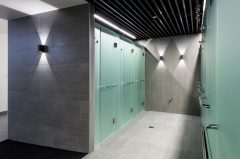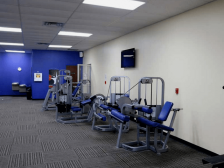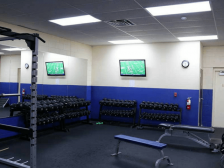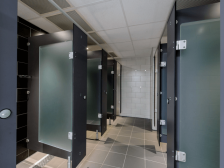Suspended Ceiling for Gym, Fitness Club
Normative Documents
When constructing and operating a sports hall or fitness center, it is necessary to comply with a set of normative documents to ensure the safety and comfort of users. In Ukraine, for such purposes, the following normative documents should be observed:
- DBN V.2.2-16-2006 “Design of Sports and Physical Education Institutions”: This standard outlines requirements for designing sports facilities, including gyms and fitness centers.
- DBN V.2.2-12-2006 “Sound Insulation”: This document regulates sound insulation in sports halls, which is crucial for preventing noise and ensuring comfortable conditions for activities.
- DBN V.2.6-31-2006 “Internal Water Supply and Drainage of Sports and Physical Education Institutions”: This standard establishes requirements for internal water supply and sewage systems in sports facilities.
- DBN V.2.2-22-2009 “Design of Lighting”: This document provides recommendations for lighting design, important for ensuring safe training and competitions.
Compliance with these normative documents will help create a sports space that meets safety and quality standards.
Engaging in sports requires maximum concentration, especially in situations where one needs to “push themselves to the limit.” When designing sports halls, fitness rooms, and similar facilities, every detail matters – each detail can either help a person exercise or, conversely, distract them. Ceilings are no exception to this rule. While it’s possible to exercise in a simple room with a whitewashed ceiling, choosing a gym where the ceiling is designed according to the basic requirements for such structures is essential. In this overview, we will discuss these requirements and what the ceiling in a gym can look like.

Gyms and Sports Clubs – Spaces with Special Conditions
Spaces designed for sports activities have a quite specific climate regime. This is because sports are energy-consuming, and good results can only be achieved under certain conditions. What should be considered when designing a gym?
- Temperature: Typically, sports halls maintain a temperature regime comfortable for active individuals. It is slightly cooler than in other rooms. During colder seasons, this is achieved by reducing heating intensity, while in summer, air conditioning in the hall must be operational.
- Humidity: When actively engaged in sports, individuals sweat, and moisture enters the air in large volumes. While some of it is removed by ventilation, the humidity in sports halls is generally higher than in, for example, office or residential spaces.
- Air Exchange: During sports activities, individuals actively consume oxygen. Therefore, to avoid oxygen starvation, forced air exchange (where fans provide not only exhaust but also supply air) is organized in the room.

Requirements for Ceilings in Sports Halls
All of these factors influence the requirements that suspended ceiling systems must meet:
- Firstly, the construction must be moisture-resistant; otherwise, the ceiling will constantly deform in conditions of constantly changing humidity.
- Secondly, it is important to choose products for suspended ceilings that are minimally prone to temperature deformations (the temperature difference over several hours – after closing the hall or after the start of active classes – can be 10-15 degrees).
- Thirdly, the ceiling structure should allow the placement of ventilation grilles and ducts: the elements of the system should be evenly distributed over the area of the sports hall.
Other aspects are equally important:
- Ideally, the suspended ceiling should accommodate a lighting system – effective lighting is crucial for successful sports activities.
- The color palette of the ceiling is also important – therefore, when choosing a material for its finishing, the possibility of manufacturing components in different shades should be considered.
- Finally, safety and sanitation are crucial. Firstly, the sports hall is a place of mass gatherings, so the ceiling (and all finishing materials) must meet fire safety requirements. Secondly, the room needs regular cleaning – so the ceiling should withstand wet cleaning (possibly with the use of special chemical compounds).
As you can see, the requirements are quite strict, and not all suspended constructions meet them. Below, we will analyze the main types of suspended ceilings and focus on their applicability in finishing sports halls.

Traditional Suspended Ceilings: Drywall and Armstrong
To reduce costs for finishing a room during the installation of suspended ceilings, either drywall or the Armstrong suspended system is usually used.
The advantages of such constructions include:
- Low cost.
- Easy installation.
- The possibility of choosing a shade.
- The ability to install built-in lighting.
However, unfortunately, neither a drywall suspended ceiling nor an Armstrong ceiling can be called an ideal solution for decorating a gym. There are several reasons for this:
- The porous structure of the material leads to the accumulation of moisture. Moisture, adsorbed by drywall or ceiling tiles from the air, penetrates between the fibers, resulting in swelling and deformation of the ceiling finish.
- There is also a tendency for drywall and fiberboard to undergo temperature deformation, so over time, the ceiling structure may begin to crack. This is especially relevant for drywall ceilings finished with a thin layer of putty and painted with interior compositions.
- A drawback is also the relatively low mechanical strength. Yes, at a sufficient height of the ceiling, it will be much more difficult to damage it with an awkward movement – but still, in a gym, a more robust and durable ceiling covering would be preferable.
METAL SUSPENDED CEILINGS
Metallic elements constructions (an excellent example being the suspended metal ceiling from the “MehBud” factory) can serve as an alternative to traditional suspended ceilings. They come in various forms, and we will explore the main groups of such ceilings below.
RACK SYSTEMS
For small gyms and auxiliary spaces such as corridors, changing rooms, and showers, metal rack ceilings made of steel or aluminum are excellent choices. The system, consisting of long, narrow racks, is easy to install, providing access to the ceiling space where utilities are located.
The advantages of rack ceilings for gyms include:
- Attractive appearance with design options.
- Simple and fast installation.
- High fire and moisture resistance.
- Easy maintenance and compatibility with regular wet cleaning.
CASSETTE AND PANEL SYSTEMS
If you need to cover a large area, consider cassette and panel ceilings for spacious gyms or extensive shower rooms. These systems are suitable for reconstruction projects, especially when Armstrong ceilings were previously installed, as standard metal cassette sizes allow for mounting on existing suspension systems with minimal modifications typically made to increase load-bearing capacity.
Cassette and panel metal ceilings offer several advantages:
- Comparable moisture resistance, preventing deformation over time.
- Large panel sizes facilitate quick and easy installation.
- Compatibility with standard-sized built-in lights, including LED panels.
- Integration of 600×600 mm ventilation grilles for efficient air exchange.
CUBIC CONSTRUCTIONS
While rack and cassette metal ceilings from the “MehBud” factory are frequently used in gym interiors, the use of cubic shaped ceilings is a relatively new but justified trend.
Key benefits of cubic ceilings:
- The cubic ceiling design is versatile and suitable for almost any area.
- The use of cubic steel or aluminum beams with decorative coatings enhances durability and resistance to external factors.
- Partially open space behind the ceiling allows for the placement of ventilation system elements, improving air exchange efficiency.
- Lighting elements placed behind the cubic ceiling provide diffuse light with minimal glare, enhancing the well-being of those engaged in sports.






